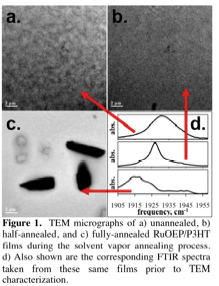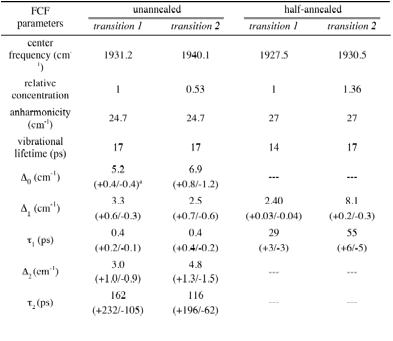Reports: G6
46628-G6 Structural Dynamics in Conducting Polymer Systems Probed with in Situ Electrochemical Two-dimensional Infrared Spectroscopy
During this funding period, we employed spectrally resolved, homodyne detected 2D-IR spectroscopy (i.e. vibrational echo spectroscopy, henceforth referred to as 2D-IR VES) to examine blended films of poly(3-hexylthiophene-2,5-diyl) (P3HT) with a carbonyl-containing ruthenium porphyrin (RuOEP) before and after a solvent vapor annealing treatment that is known to improved hole mobilities in the polymer. The goal of these efforts was to correlate structural dynamics with charge carrier mobilities. We showed earlier in the funding period that phase segregation of the two organic components could be controlled during this annealing process to generate several different microenvironments. Figures 1a-1c show the transmission electron microscope images of these progressively annealed films in the unannealed, half-annealed, and fully-annealed states. During the unannealed to half-annealed transition, there is minimal phase segregation between the RuOEP dynamics reporter and the P3HT, though dramatic changes are observed in the FTIR spectra (Figure 1d). Severe phase segregation occurs between the half-annealed and fully-annealed states, concurrent with additional changes to the FTIR spectra.
 In
conjunction with these morphological and spectroscopic changes, we found that
the hole mobilities of pure P3HT and RuOEP/P3HT films
increased by 30% going from unannealed to
half-annealed states. This is
consistent with literature reports for mobility improvements upon thermal or
solvent vapor annealing of P3HT films. We also concluded for the unannealed samples that the inclusion of the RuOEP vibrational dynamics reporter had no significant
effect on the electrical performance of the materials. This confirmed that the
vibrational dynamics probe (the CO bound to RuOEP)
served as a spectator to its P3HT surroundings without significantly altering
them during the annealing process.
In
conjunction with these morphological and spectroscopic changes, we found that
the hole mobilities of pure P3HT and RuOEP/P3HT films
increased by 30% going from unannealed to
half-annealed states. This is
consistent with literature reports for mobility improvements upon thermal or
solvent vapor annealing of P3HT films. We also concluded for the unannealed samples that the inclusion of the RuOEP vibrational dynamics reporter had no significant
effect on the electrical performance of the materials. This confirmed that the
vibrational dynamics probe (the CO bound to RuOEP)
served as a spectator to its P3HT surroundings without significantly altering
them during the annealing process.
Figure 2a shows a comparison of the 2D-IR vibrational echo decays collected at Tws of 0.5 and 15 ps for the unannealed state measured at 1931 cm-1. As Tw is increased from 0.5 ps to 15 ps, the vibrational echo signal decays faster with a minimal peak shift towards the origin. This indicates that a small amount of spectral diffusion occurs for the ruthenium-bound CO in response to structural motions in the polymer film on the timescale of tens of picoseconds. In comparison, Figure 2b shows the echo decays collected at Tws of 0.5 ps and 15 ps for the half-annealed state measured at 1925 cm-1. At first glance, the large peak shift in the half-annealed sample data, typically ascribed to greater inhomogeneity, is surprising in light of the narrow inhomogeneously broadened linear lineshape (see Figure 1d). However, this simply reflects the inability of the linear observation to predict the molecular dynamics of the system. One dynamical explanation for the peak shift in Figure 2b is that a drastic decrease in the timescales of frequency fluctuations has occurred, pushing some of the dynamics into the motionally-narrowed regime.
The 2D-IR VES and FTIR data for each annealed state were collectively fit to a frequency correlation function (FCF) with a bi-exponential plus a constant form using non-linear response theory. In this equation, Di is interpreted as the amplitude of a dynamic process or frequency perturbation having a timescale of t1, and D0 represents static inhomogeneity and polymer dynamics that occur on timescales longer than several vibrational lifetimes (>100 ps). The FCF fitting parameters for the unannealed and half-annealed states are compiled in Table 1. For the unannealed RuOEP/P3HT film the two dominant timescales of dynamic components of the FCFs are 400 fs and greater than 100 ps for both of the transitions (see Table 1). The long timescale dynamic components in these FCFs are very slow, consistent with the minimal peak shift noted in Figure 2a, however they are necessary to fit the accelerated echo decays at longer Tws. Combining these parameters with the D0s of 5.2 cm-1 and 6.9 cm-1, it can be concluded that the majority of the peak shift in that figure is the result of static inhomogeneity or very slow dynamics (longer than tens of ps).
 Two
features of the unannealed sample FCFs are notably
absent in the half-annealed FCFs: The static inhomogeneity (D0) and the 400 fs dynamic components. The lack of a significant D0
is consistent with the narrow width of the steady-state absorption spectrum, however, the absent dynamic component could not
have been predicted without the use of a 2D-IR methodology. The
observations of large peak shifts in Figure 2b and narrow linear lineshapes are
explained by the transition of the 400 fs dynamic
term in the FCFs for the unannealed
sample to a motionally-narrowed exponential component
in the FCFs for the unannealed sample.
Two
features of the unannealed sample FCFs are notably
absent in the half-annealed FCFs: The static inhomogeneity (D0) and the 400 fs dynamic components. The lack of a significant D0
is consistent with the narrow width of the steady-state absorption spectrum, however, the absent dynamic component could not
have been predicted without the use of a 2D-IR methodology. The
observations of large peak shifts in Figure 2b and narrow linear lineshapes are
explained by the transition of the 400 fs dynamic
term in the FCFs for the unannealed
sample to a motionally-narrowed exponential component
in the FCFs for the unannealed sample.
Referring back to the electrical data taken on these films, as the annealing proceeds and the mobility increases by 30% from the unannealed to the half-annealed state, the FCFs obtained by fitting the 2D-IR VES data indicate a concurrent loss of vibrational dephasing with a time constant of 400 fs. Low frequency ring torsional vibrations have been calculated for poly(phenyl) and poly(thiophene) systems to be in the range of 60 to 130 cm-1. A damping of torsion motions in the 100-200 cm-1 regime would be expected with a decrease in the interchain spacing and an increase in pi-orbital stacking, leading to higher carrier mobilities. Our experimental evidence in this work supports the notion that mobility enhancements can originate in both static and dynamic structural changes.

Table 1. FCF parameters used to fit
2D-IR VES data.
a. Values in parenthesis demonstrate positive and negative uncertainties as defined in the text.




